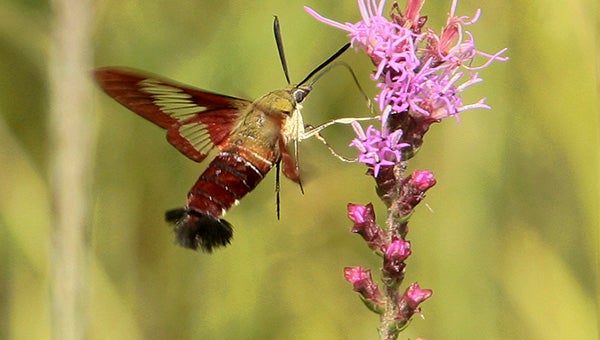Arboretum Paths: It’s about to get really buggy
Published 7:00 am Wednesday, September 9, 2015

Photographer Lana Gramlich caught this shot of a “hummingbird moth” in our Pitcher Plant Bog. Due to its flight pattern, the insect is often mistaken for a hummingbird.
Photo by Lana Gramlich
In only a week and a half, the waiting will be over and another Bugfest will be here! Yes, this is the time of the year when insects take center stage at the Arboretum and it will be – bugs, bugs, bugs.
Whether the topic of insects gives you that creepy crawly feeling or you are a die-hard fan, we hope you will join us September 18 and 19 for a buggy good time, when forest and field will be full of people enjoying the many activities that are part of this event that celebrates the insect world.
Bugfest is made possible by the Mississippi State University entomology faculty and students, a component of the Department of Biochemistry, Molecular Biology, Entomology and Plant Pathology. The event has been guided by Extension Professor Dr. John Guyton for over 10 years.
For youth intrigued by insects, the MSU department offers an outstanding summer bug camp, and a beekeeping camp. Dr. Guyton leads the bug camp, and co-leads the beekeeping camp along with MSU beekeeping specialist Dr. Jeff Harris. Both will be present at this year’s Bugfest. Interested in learning more about beekeeping? A live bee colony, donated by member D. L. Wesley of Foxworth, Mississippi, will be on display during the event.
There may even be a spider or two in the mix. Although spiders have eight legs and classified as arachnids, not insects (which have six legs), but often come to mind when people think about insects.
Only a small portion of the world’s million or so insect species are pest species or considered harmful to humans. We may think of them as generally pesky, but most insects have important roles, for example, in nutrient recycling or aiding plant pollination. Many of the world’s nations consume insects, called entomophagy. Insects have a very high protein content, and are very plentiful.
Enter the term, or “insects as food”, or “insect cookbook” into an Internet search engine and you will soon be immersed in a whole new world. You’ll even find a variety of recipe books on the subject. It’s possible your revulsion may turn to fascination, and you just might solve the problem of locating the perfect gift for that one person on your Christmas list who is always hard to buy for.
Do you know your state bugs? In Mississippi, our state insect is the honey bee, and our state butterfly is the spicebush swallowtail. Visit the MSU Extension Service website at http://msucares.com/ and enter the key words “4-H Entomology” or “insect collecting” in the search field to see answers to frequently asked questions about entomology, and much more. The Extension website offers numerous publications to aid in your study and identification of insects, in addition to information on controlling household insect pests.
Have an insect you can’t identify? You may submit a photo or mail the specimen to the MSU Extension Entomology Insect Identification Lab. There is no charge for individual samples submitted by Mississippi citizens. For directions on submissions, seehttp://msucares.com/insects/insect_id_service/. You can also bring in specimens from home to the entomology station on the Pinecote Pavilion during our two-day Bugfest event.
Why study insects? Find these answers in the condensed 4-H Entomology Handbook, a 40-page reference guide you may download at no charge you from the Crosby Arboretum website at http://crosbyarboretum.msstate.edu/. From this home page, click the Bugfest banner to access the September program calendar page and click on the beetle to download the handbook. The manual contains an overview of the Bugfest event, provides a fascinating world history of entomology, and outlines how to make and where to order basic collecting equipment. Do you have someone in your family who can’t stop themselves from following every bug they encounter? This manual could be their next step to a lifelong hobby or even a career in entomology.
Make your plans to celebrate insects at Bugfest on September 18 and 19. A workshop on planting fall garden containers led by senior curator Jill Mirkovich will be held September 26.
For more information, call 601-799-2311 or see our website. The Arboretum is open Wednesdays through Sundays from 9 a.m. to 5 p.m. and located in Picayune, off I-59 Exit 4, at 370 Ridge Road (south of Walmart and adjacent to I-59).
By Pat Drackett





